Workload Management: Ultimate Guide to Efficiency
Workload management balances tasks evenly across employees according to availability, skill sets, and overall business goals.
Without it, your business will be sinking time into unprofitable projects, burning out key employees, and losing its competitive edge. How do you avoid this?
With the best practices for improving business-wide efficiency and productivity discussed in this guide.
Key Takeaways
- Workload management includes a set of business processes for improved time management, balanced task lists, and healthy project life cycles.
- The benefits of optimizing your workload management process include reduced employee stress, increased productivity and efficiency, and improved project delivery.
- Best practices for project managers are: effective delegation and resource scheduling, task and project prioritization, managing expectations, and communication and transparency.
Free Capacity Planning Template
Download our template to schedule time for billable vs non-billable tasks, track workloads, and get insights into utilization with preset formulas.

What Is Workload Management?
Workload management is the process of scheduling tasks across one or multiple project teams to promote achievable deadlines and balanced workload capacity.
It includes:
- Planning work
- Prioritizing essential activities
- Organizing task lists
The main goal of workload management is to ensure that the entire team has just the right amount of work assigned. Too much and you risk burnout; too little, and you might be underutilizing your employees.
This can lead to decreased job satisfaction, disengagement, and ultimately, employee attrition (which can be quite costly for your business — according to research by American Progress, up to 20% of an employee’s annual salary).
Learn more about the importance of scheduling teams for billable and non-billable hours.
The Importance of Workload Management
According to research by Gallup, engaged employees are more focused and efficient. They are better aligned with customer needs, and they pay closer attention to processes, standards, and systems.
Collectively, the behaviors of highly engaged teams contribute to a 23% increase in profitability.
Workload management helps increase engagement by:
- Combatting unrealistic deadlines across numerous projects
- Ensuring that individual workloads are appropriate
- Improving communication and progress visibility
- Reducing employee stress by clarifying actual workload
- Creating a capacity development plan for professional growth
Ultimately, proper workload management not only supports team productivity but also plays a crucial role in retaining top talent. This helps your agency stay resilient and sustainable, providing a competitive edge in your industry.
Workload Management vs Resource Management
Workload management is a narrower term that encompasses the management of human resources within a business. It involves distributing and managing tasks in a way that prevents workload issues and delays in project milestones.
Resource management is a broader approach that involves the management of all resources within an organization. This includes human resources, finances, facilities and equipment, and other resources depending on your industry and company.
Another important distinction is between capacity planning vs. resource planning, where capacity planning is seen as a broader, strategic process. In comparison, resource planning is more tactical and concerned with day-to-day processes.
Main Challenges in Workload Management
Some of the main challenges of workload management include: Understanding current business availability, efficiently managing resources for long-term competitiveness, implementing effective change management, and tracking progress accurately with capacity planning KPIs.
1. Understanding Team Capacity
Identifying a team’s capacity means understanding what each employee can do, when they’re available, and how to best utilize them to achieve business priorities. Calculating the billable utilization rate is a popular way to gauge the productivity of a specific department or employee.
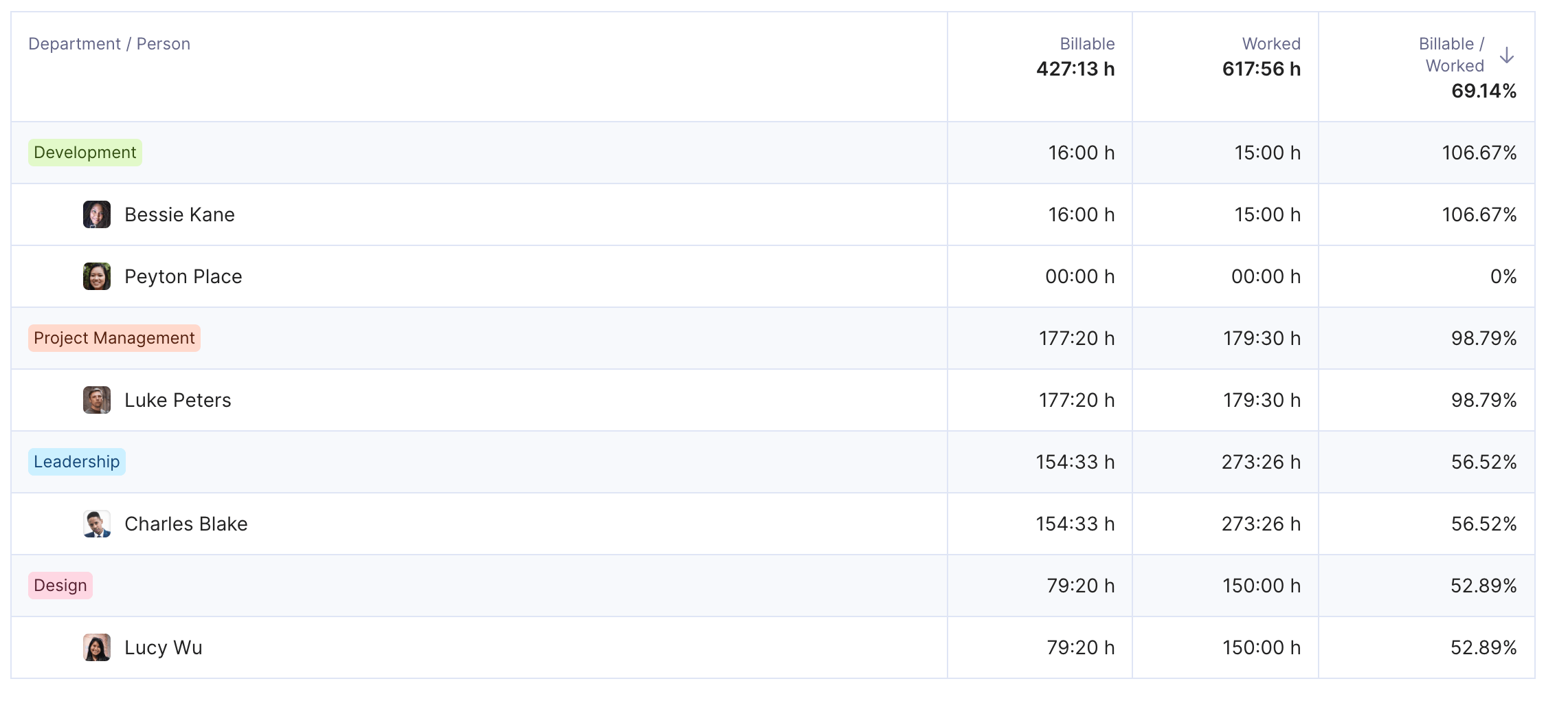
Visualize and forecast your utilization rate with Productive
The utilization rate is the ratio of billable vs non-billable hours spent on work to the total available working hours. It can be measured across various metrics, such as seniority, department, or specific projects, to bring more nuance to your insights.
Keep in mind that both billable and non-billable hours are valuable for your workforce planning. Billable hours bring direct profit, but non-billable hours include crucial activities such as:
- Skill building
- Administrative tasks
- Project pitching
2. Managing Resource Pools
Efficient management of your resource pool includes:
- Operational or day-to-day management: Operational management involves scheduling your human resources, managing project schedules, and preventing uneven workload distribution on a daily basis (learn more about creating a resource management plan).
- Strategic or long-term management: Strategic management includes forward and proactive thinking, considering the future needs of your business and how to achieve them by leveraging your human resources. This includes various strategic HR planning tasks such as succession planning, reskilling or upskilling, and talent retention.
Optimize Your Workload Management
Businesses use Productive to get comprehensive insights into their employees and how to best utilize them.
3. Adapting to Project Changes
According to a PMI report, nearly 50% of projects experience scope creep. Two of the main reasons for this usually include:
- Setting and maintaining unrealistic expectations
- A lack of ability to gauge the effect of scope changes
Unrealistic expectations might be caused by a lack of historical data on previous projects, a misunderstanding of project complexity, or a desire to overdeliver to satisfy clients.
The other is usually caused by a lack of a reliable solution for tracking real-time data. For example, some resource management software (such as Productive) offers financial forecasting capabilities.
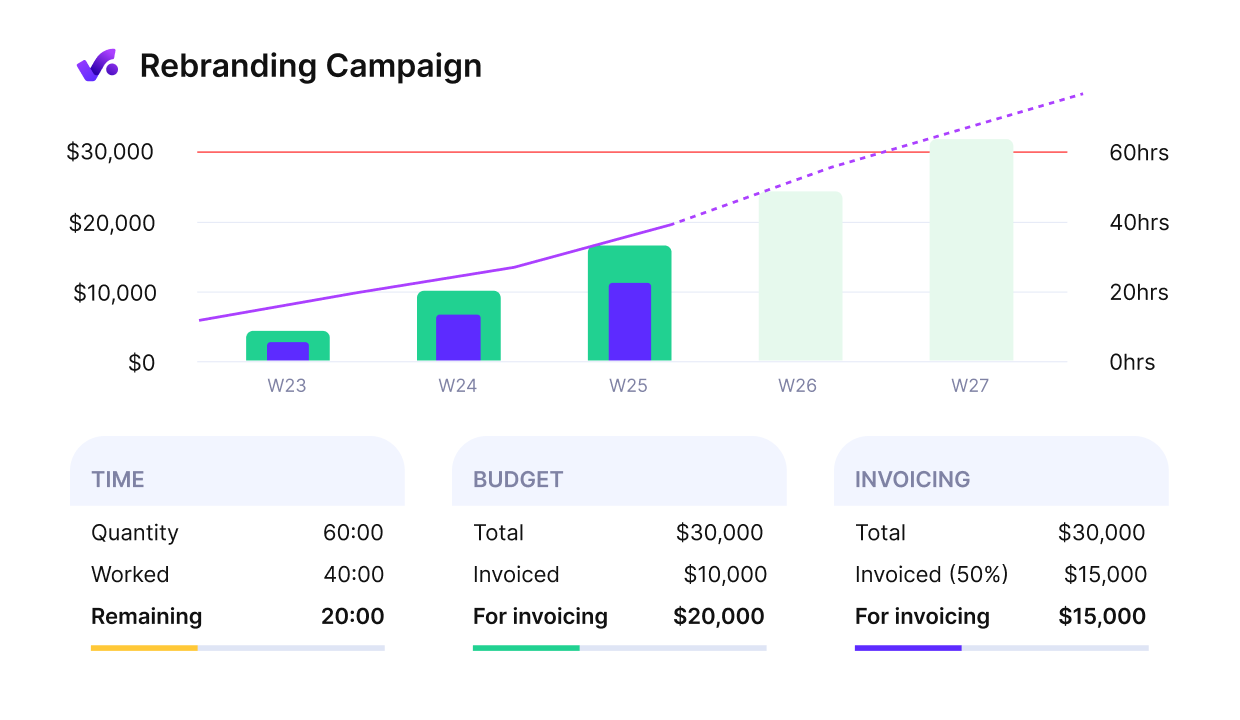
Get real-time data on essential metrics for capacity planning
This means that you can view the effect your workload allocation has on financial metrics, such as revenue and profit margins, across the entire project duration. This can be an invaluable tool for making informed business decisions.
4. Tracking Progress Accurately
Two key aspects of accurate project progress tracking include having a reliable system for real-time data and understanding which KPIs are crucial for specific initiatives.
For example:
- For initiatives aimed at building employee satisfaction, key performance indicators (KPIs) might include employee engagement scores, turnover rates, and feedback from satisfaction surveys.
- For productivity improvements, KPIs could encompass metrics such as output per hour, efficiency ratios, and the percentage of projects delivered on time.
- For enhancing project performance, relevant KPIs might involve milestone achievement rates, budget adherence levels, scope change frequency, and overall project completion times.
Setting target goals for each of your KPIs is equally important for ensuring you’re on the right track.
The Role of Resource Managers
The duties of a resource manager are complementary to the managerial roles of a project manager.
The resource manager role is more people-oriented — it focuses on managing human resources, finances, and facilities across multiple projects.
The project manager role is project-oriented — it focuses on managing projects from initiation to completion, ensuring the quality of deliverables, and communicating with stakeholders.
While project managers usually focus on one or more specific projects, the resource manager works on an organizational level. They perform workforce planning to ensure the business can operate sustainably in the long term.
What Is Workload Overload? Main Causes
Workload overload occurs when the demands placed on an employee exceed their capacity to complete their tasks effectively. This can involve too many tasks, tasks that exceed employee capability or experience, or unrealistic deadlines.
However, it can also happen when the workload is moderate or well-suited to capabilities.
For example, even light workloads might become heavy if employees are disengaged or unmotivated. Disengagement can be caused by:
- Long-term work on repetitive tasks
- Loss of perspective for the overarching business goals
- Lack of personal progression within the company
- Inadequate compensation
According to statistics by McKinsey, employee disengagement and attrition can cause companies $1.1 billion in lost company value over five years.
This is why it’s so important to recognize the main symptoms of workload
overload early, including:
The Main Symptoms of Workload Overload
- Working late hours
- Overtime work
- Drop in quality
- Missed deadlines
- Chronic fatigue
- Decrease in communication
- Health issues and burnout
How to Prevent Burnout
Burnout is one of the most damaging consequences of heavy workloads. Unlike workplace stress, which is usually temporary, burnout results from long-term issues with overwhelming or unbalanced workloads.
Unlike stress, burnout is also more challenging to resolve succcessfully. According to the BusinessWire, employee workload is responsible for up to half of annual workforce turnover in 50% of businesses.
Some of the main strategies for preventing burnout include:
- A strength-based approach to the employee lifecycle to foster a culture of development
- Focusing on creating a healthy environment by monitoring management behavior (have you heard the phrase: people don’t quit jobs, they quit managers?)
- Upskilling bosses to provide meaningful feedback for nurturing employee growth
- Aligning professional growth with personal wellbeing
Consideration should also be given to managers, who are highly susceptible to burnout. The signs and preventative strategies outlined above are essential for their personal development and well-being.
Strategies for Managing Team Workload
Managing your workload effectively involves key components such as:
- Effective task scheduling and delegation
- Strategic prioritization, especially for complex projects
- Managing client expectations
- Team communication and transparency
1. Delegating Tasks
Effective workload management begins with task scheduling and delegation. This includes identifying what needs to be done and when and organizing this into a resource planning template.
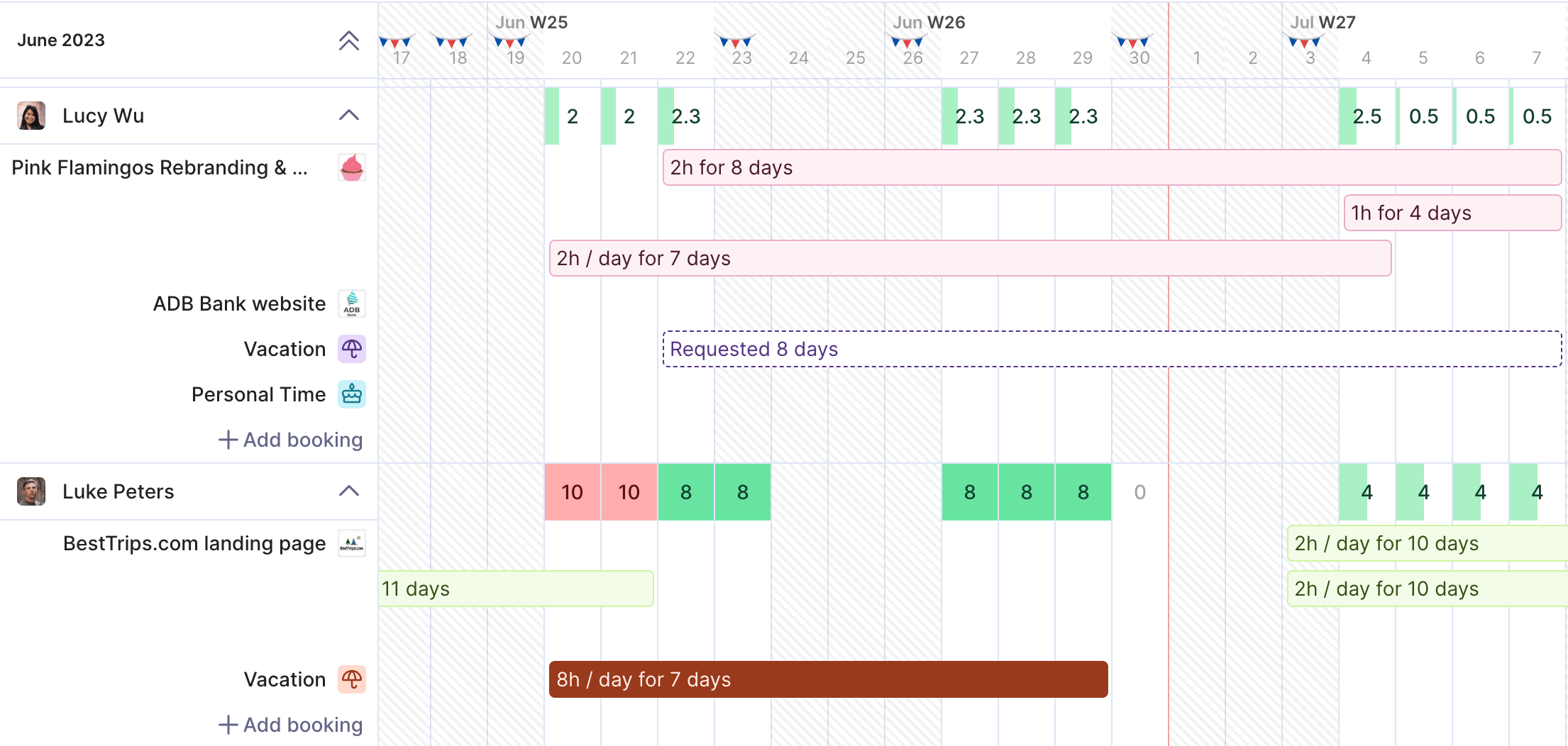
Manage your current workload with Productive’s Resourcing module
Some of the strategies used include:
- Identifying strengths and weaknesses: Understand your team’s abilities and assign tasks to employees who’ll perform them best.
- Define your expectations: Clearly communicate the task’s objectives, deadlines, and expected results to avoid confusion.
- Provide support and feedback: Offer assistance and constructive feedback to ensure that tasks are going according to plan — but make sure not to micromanage the process.
2. Prioritizing Crucial Work
Strategic prioritization is key, especially considering that project managers can handle from five to ten projects simultaneously (RGPM).
It’s essential to determine urgent tasks or strategic workloads, but also to identify which projects are your top priority. While it might be tempting to commit equally to each project, this is more likely to lead to burnout than quality delivery.
Overservicing can be a big issue — according to PR Week, nearly one in five agencies are overservicing every single account. This can stretch your human resources thin and negatively impact your profitability.
We ended up terminating contracts with two of our oldest clients after only a few months of using Productive. We thought that we were at least at zero with them, or that we had some small earnings, but it turned out that we were losing money because the money they paid us did not cover salaries, fixed overhead per hour, and variable overhead per hour.
Learn more about the specifics of handling resourcing for multiple projects.
You can support your prioritization by using software that provides oversight into all tasks assigned to team members, across multiple projects.
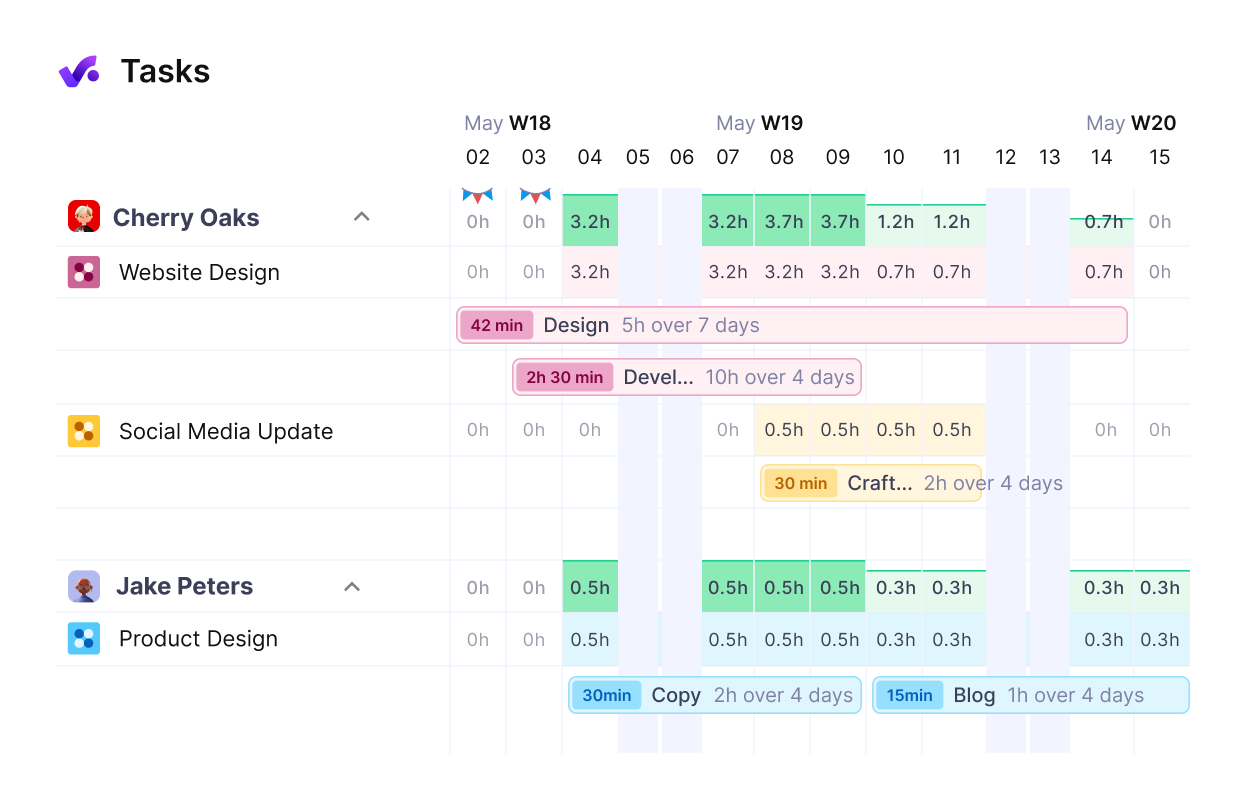
USE PRODUCTIVE’S WORKLOAD VIEW TO visualize how tasks are distributed across team members and projects
3. Managing Client Expectations
Setting clear expectations from the outset is important for managing various situations that may occur during the project’s progress.
To give an example, one of the weak points of website project management is the maintenance phase. Clients and service providers might have different notions of what this may include — bug fixes vs implementing new features.
Having to commit to a project you thought was completed can significantly impact your ability to take on new projects that bring in business profits.
Another critical aspect is promoting mutual transparency. If clients have a clear understanding of your project tasks and the progress that has been made, they will be more willing to compromise and discuss changes.
Workload management tools that provide task transparency with client access can help you achieve proactive communication, saving you future time and trouble.
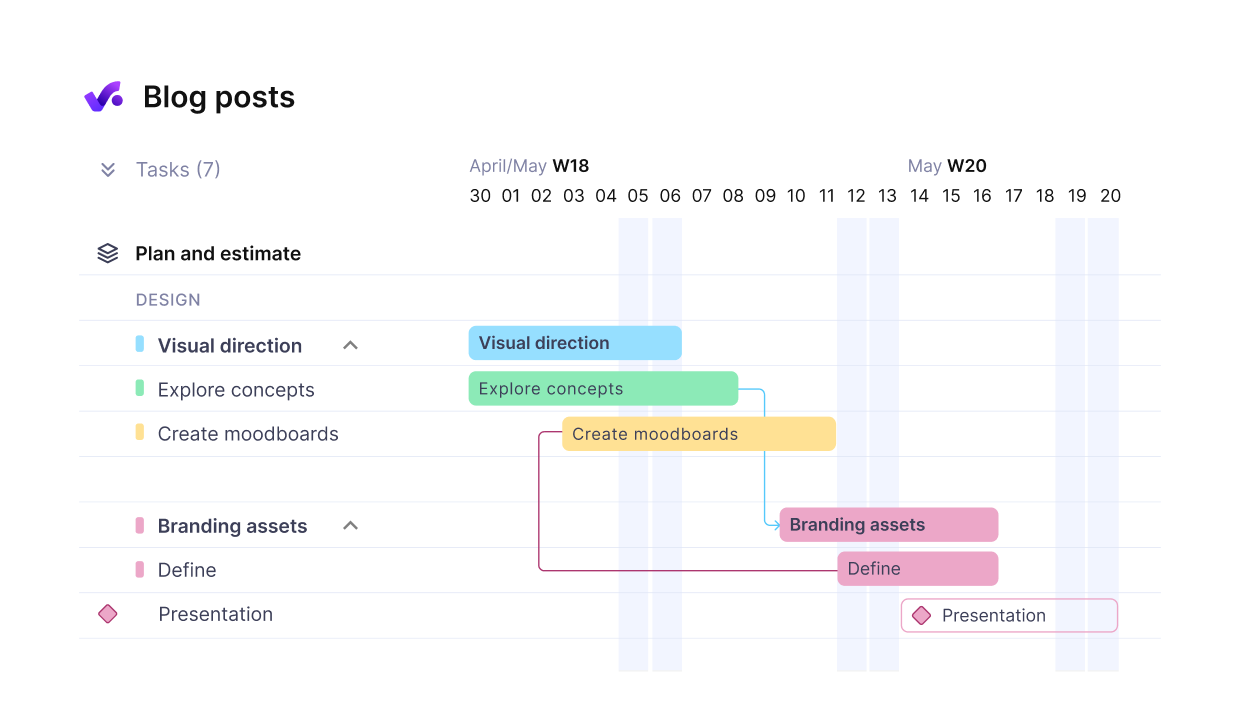
Productive’s Gantt charts provide full transparency into your project progress
4. Effective Team Communication
Strategies for effective and transparent communication extend to your project teams as well as clients.
Providing a clear overview of:
- Employee workload across a project
- Who is responsible for what
- How each task affects the overall project milestones
Can help project teams and employees self-manage and maintain engagement and productivity.
It also reduces stress, as everyone is clear on their obligations and how to complete them effectively.
Some valuable features of team workload management tools that can help you achieve this are status updates on tasks, automatic notifications, managing updates through the comment history, organizing work through project boards, and more.
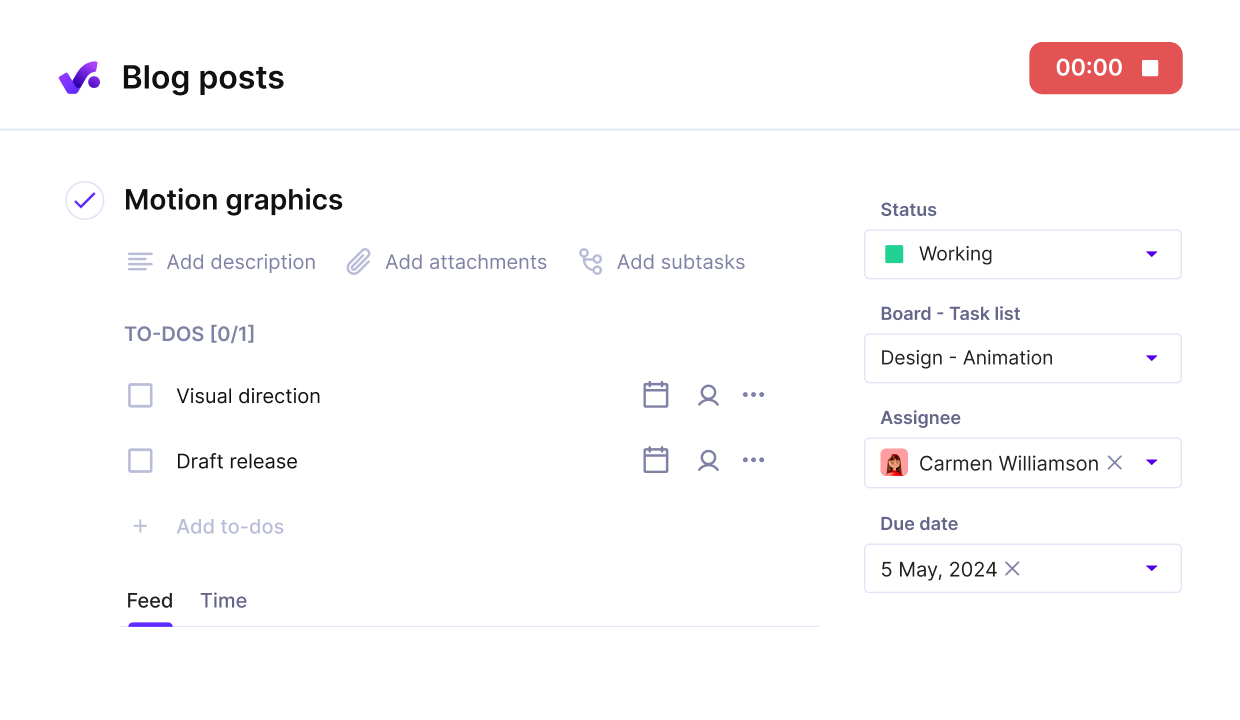
Gather all communication in one place with Productive’s project and task management
Tips and Tricks for Personal Workload Management
One part of a manager’s work is to ensure that the workload management process is smooth for individual teams.
However, applying these strategies to personal workflows is the other equally important part.
Some tips for more efficient personal workloads include:
- Healthy work-life balance: Prioritize your health and personal time just as you would work tasks to prevent burnout and maintain overall well-being.
- Blocking out time: Dedicate specific periods for focused work, allowing for more efficient task completion and reducing distractions.
- Set realistic deadlines: Estimate the time needed for tasks accurately, considering potential obstacles to ensure deadlines are achievable.
- Two-minute rule: Immediately tackle tasks that can be completed in two minutes or less to reduce your to-do list and maintain momentum.
- Task batching: Group similar activities together to minimize context switching, enhancing focus and productivity.
- Pomodoro Technique: Work in short, intense bursts followed by brief breaks to maintain high concentration levels and avoid fatigue.
- Utilize time tracking: Monitor how you spend your time to identify areas for improvement and better allocate your hours.
Strategic Workload Planning
Strategic workload management is different from day-to-day workload management. It includes looking further into the future to ensure that your business can meet potential customer needs.
The top three strategies that it includes are:
- Needs Forecasting: Analyzing market trends and customer feedback to predict future demand and prepare accordingly.
- Capacity Building: Investing in resources and training to expand your team’s abilities and increase your capacity to take on future projects.
- Alignment with Business Goals: Ensuring that workload management strategies are in sync with the overarching objectives of the business.
1. Needs Forecasting
Needs forecasting involves examining data on market trends, customer feedback, and historical patterns to predict future demand. For example, a retail company might examine holiday sales data over several years to anticipate inventory needs for the upcoming season.
This proactive approach allows businesses to adjust their strategies. Popular strategies for matching capacity with demand include lead strategy (which increases capacity before it’s needed) and lag strategy (which increases capacity when the demand has already surpassed it).
2. Capacity Building
Capacity building focuses on developing your team’s skills and expanding your operational capabilities to handle increases or changes in demand.
The two main types of capacity building include:
- Upskilling, where employees learn new skills complementary to their current job requirements.
- Reskilling, which includes training employees in entirely new skills or roles that differ from their current job functions.
A practical example is a digital marketing company investing in advanced training for emerging technologies, such as artificial intelligence. By doing so, the company improves its current project delivery and prepares to take on future projects requiring this capacity.
3. Aligning Strategies With Business Goals
Finally, aligning workload management strategies with business goals ensures that every project and task contributes to the overarching objectives of the organization.
For example, if a business aims to expand into a new market, its workload management might prioritize hiring resources with competitive skills or upskilling current talent.
This alignment requires regular review of business goals and workload management strategies to adjust priorities with changing circumstances.
Workload Management Software & Tools
The benefits of using ERP software for business management can include improved internal collaboration (34%), improved delivery (28%), improved employee productivity (23%) and engagement (17%).
Software with workload management features can help you gather data from various activities and improve your processes. Project management tools also support task prioritization, team collaboration, utilization tracking, and workflow automation.
When looking for your top software choice, consider:
- Scalability
- User-friendliness
- Customer service
These three criteria are essential for promoting adoption across the entire team. Additionally, scalability is important for ensuring your software can grow alongside your agency.
One of the best tools that provides all three for agencies is:
Productive — The Top Agency Software for Workload Management
If you’re interested in comprehensive software for workload management, Productive is your top choice.
It’s a software solution designed by industry veterans that caters specifically to agency workflows. Core features include resource management, budgeting and billing, and project planning.
The fact that Productive is agency-focused means that the whole ecosystem fits together so that there are fewer tools we have to pull together in order to do what we need to do.
Additional capabilities that support workload management include:
- Time tracking with multiple ways to manage entries
- Financial forecasting and utilization insights
- A Resourcing module for easy scheduling and oversight
- Integrated time off management
- Project and task management for improved collaboration
- Workload view for visualizing task distribution across employees and projects (distinct from Resourcing)
- No-code workflow automations to boost efficiency
Additional features include: sales performance management, AI-ready Docs, project budgeting and billing, real-time reporting, custom permissions, and integrations with third-party software.
Book a demo today to discover what Productive can do for your business.
Connect With Agency Peers
Access agency-related Slack channels, exchange business insights, and join in on members-only live sessions.

